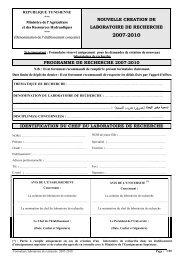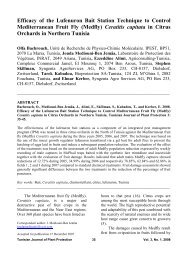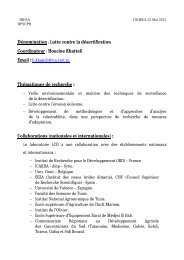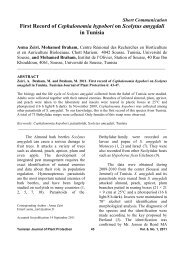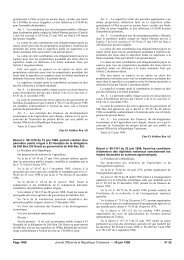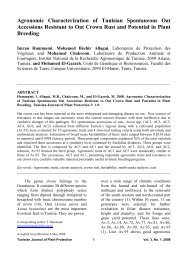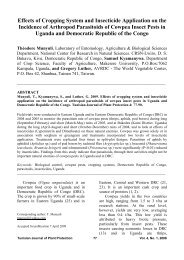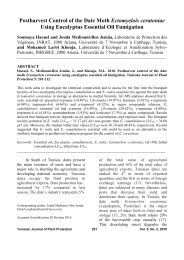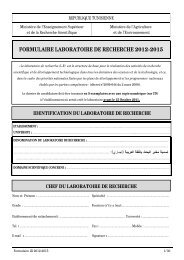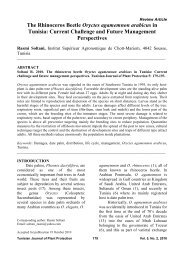Phase Characteristics of the Desert Locust Schistocerca gregaria ...
Phase Characteristics of the Desert Locust Schistocerca gregaria ...
Phase Characteristics of the Desert Locust Schistocerca gregaria ...
Create successful ePaper yourself
Turn your PDF publications into a flip-book with our unique Google optimized e-Paper software.
<strong>Phase</strong> <strong>Characteristics</strong> <strong>of</strong> <strong>the</strong> <strong>Desert</strong> <strong>Locust</strong> <strong>Schistocerca</strong><br />
<strong>gregaria</strong> Swarming Populations During <strong>the</strong> 2004 Outbreak in<br />
Tunisia and that <strong>of</strong> 2005 in Algeria<br />
Mohamed Ammar, Institut National Agronomique de Tunisie, 1082 Tunis, Tunisia,<br />
Amel Ben Hamouda Institut Supérieur Agronomique de Chott Mariem, 4042<br />
Sousse, Tunisia, Sadreddine Kallel, Institut National Agronomique de Tunisie,<br />
1082 Tunis, Tunisia, Khaled Moumène, Institut National de la Protection des<br />
Végétaux, El-Harrach, BP 80 Alger, Alegria, and Mohamed Habib Ben Hamouda<br />
Institut Supérieur Agronomique de Chott Mariem, 4042 Sousse, Tunisia<br />
__________________________________________________________________________<br />
ABSTRACT<br />
Ammar, M., Ben Hamouda, A., Kallel, S., Moumène, K., and Ben Hamouda, M.H. 2009. <strong>Phase</strong><br />
characteristics <strong>of</strong> <strong>the</strong> desert locust <strong>Schistocerca</strong> <strong>gregaria</strong> swarming populations during <strong>the</strong> 2004<br />
outbreak in Tunisia and that <strong>of</strong> 2005 in Algeria. Tunisian Journal <strong>of</strong> Plant Protection 4: 145-156.<br />
<strong>Desert</strong> locust (<strong>Schistocerca</strong> <strong>gregaria</strong>) collected from <strong>the</strong> district <strong>of</strong> Tataouine South-East <strong>of</strong> Tunisia<br />
during spring 2004 outbreak showed 4.6% <strong>of</strong> solitary form in swarming population. While desert<br />
locusts collected during 2005 from <strong>the</strong> district <strong>of</strong> El Oued South-East Algeria showed almost no<br />
solitaries form which is in concert with a higher control gregarization level reached during <strong>the</strong> second<br />
year <strong>of</strong> outbreak. These locusts were coming directly from Sahelian countries which were unable to<br />
organize anti-locusts programs, since as was mentioned <strong>the</strong> FAO that <strong>the</strong> aerial spraying operations<br />
against locusts was insufficient. The discriminate analysis based on <strong>the</strong> overlap <strong>of</strong> <strong>the</strong>se two<br />
populations revealed that <strong>the</strong>y are thoughtlessly conspicuous. Morphometric parameters related to<br />
pronotum length and <strong>the</strong> head width have contributed <strong>the</strong> most in <strong>the</strong> discrimination between <strong>the</strong>se<br />
populations.<br />
Keywords : Algeria, morphometrics, phase characteristics, plagues, <strong>Schistocerca</strong> <strong>gregaria</strong>, Tunisia<br />
__________________________________________________________________________<br />
During one century, <strong>the</strong> continuous <strong>the</strong> discovery <strong>of</strong> <strong>the</strong> gregarizing areas, <strong>the</strong><br />
ecological researches development led to understanding <strong>of</strong> <strong>the</strong> key factors <strong>of</strong> plague<br />
<strong>the</strong> understanding <strong>of</strong> locust phase activation and finally <strong>the</strong> adjustment <strong>of</strong> a<br />
polyphenism or polymorphism preventive control allowing <strong>the</strong><br />
phenomenon (a transition from <strong>the</strong> management <strong>of</strong> <strong>the</strong> natural risk performed<br />
solitary phase to <strong>the</strong> gregarious phase), by <strong>the</strong> desert locust efficiently breeding<br />
(16).<br />
Corresponding Author: M. Ammar<br />
ammar.med@inat.agrinet.tn<br />
Four concepts are important in <strong>the</strong><br />
management <strong>of</strong> locust’s control:<br />
gregarization interest, gregarigenious<br />
areas, permanent outbreak and plague<br />
Accepted for publication 27 May 2009<br />
area. The gregarization hearths can exist<br />
in <strong>the</strong> permanent area but only those<br />
situated in <strong>the</strong> gregarigenious area risk to<br />
Tunisian Journal <strong>of</strong> Plant Protection 145 Vol. 4, No. 2, 2009
lead an activation <strong>of</strong> a widespread plague<br />
(8).<br />
The breeding <strong>of</strong> <strong>the</strong> desert locust,<br />
<strong>Schistocerca</strong> <strong>gregaria</strong> (Orthoptera,<br />
Acrididae), can assume a sporadic<br />
character with alternation <strong>of</strong> remission<br />
and plagues (16). In <strong>the</strong> remission<br />
periods, solitary locusts are located in<br />
areas that occupy reduced spaces<br />
compared with <strong>the</strong> plague period. These<br />
are <strong>the</strong> gregarigenious areas whose<br />
geographical boundaries are known<br />
relatively inside <strong>the</strong> area <strong>of</strong> <strong>the</strong> locust<br />
permanent habitat.<br />
Lecoq (16) noticed that during <strong>the</strong><br />
summer 2003, unusual heavy rainfall in<br />
<strong>the</strong> Sahel, have improved rapidly<br />
generalizing swarm in <strong>the</strong> most <strong>of</strong> Sahara<br />
areas, southwards Mauritania until Sudan.<br />
Swarms and hopper bands have begin to<br />
move southwards Morocco and Algeria<br />
during autumn 2003 and have invaded <strong>the</strong><br />
whole <strong>the</strong> North Africa countries in<br />
spring 2004. Ammar and Ben Hamouda<br />
(2) showed by a morphometrical analysis<br />
<strong>of</strong> <strong>the</strong> locusts taken at <strong>the</strong> time <strong>of</strong> this<br />
plague in Douiret area <strong>of</strong> Tataouine, that<br />
South Tunisia risks to constitute a<br />
permanent habitat <strong>of</strong> S. <strong>gregaria</strong>.<br />
The comparison <strong>of</strong> <strong>the</strong>se locusts<br />
with those captured in Snad region<br />
(Gafsa) at <strong>the</strong> time <strong>of</strong> 1988 and 1989<br />
plagues revealed that South Tunisia show<br />
in fact some indications in favor <strong>of</strong> <strong>the</strong><br />
probable creation <strong>of</strong> such a permanent<br />
habitat <strong>of</strong> <strong>the</strong> desert locust (3). Permanent<br />
habitats <strong>of</strong> S. <strong>gregaria</strong> have already been<br />
revealed in 1976 by Sitouh (17) in <strong>the</strong><br />
South Algeria <strong>the</strong>n have been confirmed<br />
in 2005 by Gendouz-Benrima (14) for <strong>the</strong><br />
period 1994-2005. Abbassi et al. (1)<br />
showed <strong>the</strong> quasi permanent presence <strong>of</strong><br />
solitary populations <strong>of</strong> S. <strong>gregaria</strong> during<br />
<strong>the</strong> plague 2003-2005 in Morocco.<br />
An extend curative control measures<br />
(terrestrial and aerial) have been<br />
undertaken in <strong>the</strong> spring <strong>of</strong> 2004 against<br />
<strong>the</strong> desert locust but it did not prevent a<br />
return into <strong>the</strong> Sahelian countries where a<br />
massive plague during <strong>the</strong> summer<br />
breeding <strong>the</strong> same year has been preceded<br />
(5, 16).<br />
In this region, <strong>the</strong> control was<br />
insufficient and <strong>the</strong> whole North African<br />
country was again invaded in <strong>the</strong> autumn<br />
2004. A second intensive control<br />
campaign was made during <strong>the</strong> autumnal<br />
cold wea<strong>the</strong>r effect. These conditions<br />
have decreased plagues in <strong>the</strong> beginning<br />
<strong>of</strong> 2005 (16). However, in spring 2005,<br />
<strong>the</strong> winter breeding <strong>of</strong> S. <strong>gregaria</strong> has led<br />
to a small infestation by first stage larvae<br />
in some sites in <strong>the</strong> North-East <strong>of</strong> <strong>the</strong><br />
Algerian Sahara in El Oued area near to<br />
<strong>the</strong> Tunisian border.<br />
In <strong>the</strong> present paper, we report <strong>the</strong><br />
results <strong>of</strong> <strong>the</strong> comparison between <strong>the</strong><br />
Algerian and <strong>the</strong> Tunisian population’s<br />
locust collected in Douiret at <strong>the</strong> time <strong>of</strong><br />
2004 plague in order to provide some<br />
explanations concerning <strong>the</strong> possibility <strong>of</strong><br />
an establishment <strong>of</strong> a permanent habitat<br />
in Tunisia or in <strong>the</strong> boundary side<br />
regions.<br />
MATERIALS AND METHODS<br />
<strong>Locust</strong> collecting and breeding.<br />
First instars larvae (nearly one thousand)<br />
and egg pods (twenty) were collected in<br />
April 2005 in El Oued region, 80 km<br />
North <strong>of</strong> <strong>the</strong> village Taleb Elarbi in<br />
Algeria. The locusts were reared in <strong>the</strong><br />
laboratory under crowded (gregarious)<br />
conditions according to Ammar et al. (4)<br />
(100 insects/cage, size: 40 x 40 x 40 cm,<br />
12/12 h photoperiod, 28-30°C). Few days<br />
after fledging, locust morphometrics <strong>of</strong><br />
both sexes were measured and band eyes<br />
were counted separately (115 females and<br />
128 males in <strong>the</strong> case <strong>of</strong> “L1” population,<br />
collected at <strong>the</strong> stage <strong>of</strong> first instar larvae;<br />
44 females and 45 males in <strong>the</strong> case <strong>of</strong><br />
“W” population, collected at <strong>the</strong> stage <strong>of</strong><br />
egg pods). These two forms <strong>of</strong> locusts<br />
Tunisian Journal <strong>of</strong> Plant Protection 146 Vol. 4, No. 2, 2009
having <strong>the</strong> same parent descents,<br />
constitute <strong>the</strong> 2005 population.<br />
Adults (nearly five hundred) were<br />
collected early in <strong>the</strong> morning in April<br />
2004 from a swarm that was spread out<br />
on cultivated area in “Djessr” facing <strong>the</strong><br />
former village <strong>of</strong> Douiret in <strong>the</strong><br />
mountainous region <strong>of</strong> Tataouine South-<br />
East Tunisia. The majority <strong>of</strong> locusts was<br />
mature and was reared in <strong>the</strong> same<br />
gregarious conditions according to<br />
Ammar et al. (4) (252 females and 145<br />
males were measured). These locusts<br />
constitute <strong>the</strong> 2004 population.<br />
Morphometric measurements.<br />
Digital calipers were used to measure <strong>the</strong><br />
following classical morphometric phase<br />
characteristics for adults to determine<br />
E/F, F/C, M/C, H/C, P/C, H/P and LF/LM<br />
ratios (E = Length <strong>of</strong> fore wing, F =<br />
Length <strong>of</strong> hind femur, C = Maximum<br />
head width, M = Minimal width <strong>of</strong><br />
pronotum, H = Maximum height <strong>of</strong><br />
pronotum, P = Maximum length <strong>of</strong><br />
pronotum and L = Total length <strong>of</strong> adult:<br />
LF for female and LM for male). F/C and<br />
E/F ratios were reported on morphometric<br />
chart according to Rungs In Duranton and<br />
Lecoq (9). LF/LM ratio indicates <strong>the</strong> sex<br />
dimorphism state. It is more pronounced<br />
in gregarious phase to solitarious one (8).<br />
Number <strong>of</strong> eye stripes. The locust<br />
head are observed under loupe for<br />
counting <strong>the</strong>ir eye stripes. Solitary adults<br />
were characterized by 7 eye stripes and<br />
gregarious by 6.<br />
Statistical analyses. Data analysis<br />
was undertaken using <strong>the</strong> Principal<br />
Component Analysis (PCA) and<br />
Discriminated Analysis (DA) in<br />
STATISTICA® (7, 15).<br />
RESULTS<br />
The carry out <strong>of</strong> males<br />
morphometrical ratios <strong>of</strong> <strong>the</strong> three<br />
populations via Principal Compound<br />
Analysis (PCA) explain 84.92% <strong>of</strong> <strong>the</strong><br />
total variability and excerpt three factorial<br />
axes. The first axis explains 38.82%, <strong>the</strong><br />
second one 25.77% and <strong>the</strong> third one<br />
represents only 20.33% <strong>of</strong> <strong>the</strong> total<br />
distribution. Overall, most ratios<br />
contribute highly to PCA with <strong>the</strong><br />
exception <strong>of</strong> M/C and E/F that<br />
participates only by a small fraction <strong>of</strong><br />
<strong>the</strong>ir variability (Table 1).<br />
With females, PCA explain 88.50%<br />
<strong>of</strong> variability. It extracts also three<br />
factorial axes which explain 46.65, 25.13<br />
and 16.72% <strong>of</strong> <strong>the</strong> total distribution,<br />
respectively.<br />
Like with <strong>the</strong> male proportion, most<br />
female ratios participates highly at <strong>the</strong><br />
total variability with <strong>the</strong> exception <strong>of</strong><br />
M/C and E/F that contributes a little bit to<br />
this variability (Table 1).<br />
Table 1. Representation <strong>of</strong> male and female morphometrical ratios subjected to PCA<br />
Morphometrical ratio Female R 2 multiple Male R 2 multiple<br />
P/C 0.995408 0.991915<br />
H/C 0.995653 0.990575<br />
M/C 0.399415 0.161373<br />
F/C 0.728884 0.674526<br />
E/F 0.467182 0.596539<br />
H/P 0.995455 0.991913<br />
Tunisian Journal <strong>of</strong> Plant Protection 147 Vol. 4, No. 2, 2009
Table 2 shows that P/C and F/C<br />
ratios in males are linked and positively<br />
related to <strong>the</strong> first factorial axis. The<br />
second axis is positively connected to H/P<br />
ratio.<br />
Table 2. The coordinates <strong>of</strong> males’ morphometrical ratios measured in <strong>the</strong> plane defined by <strong>the</strong> different<br />
factors kept by <strong>the</strong> PCA<br />
Morphometrical ratio Factorial axis 1 Factorial axis 2 Factorial axis 3<br />
P/C 0.763785 -0.441458 0.292053<br />
H/C 0.588058 0.550983 0.516047<br />
M/C 0.490157 -0.210313 0.499424<br />
F/C 0.841349 0.229365 -0.358365<br />
E/F -0.635450 -0.208890 0.676438<br />
H/P -0.219916 0.952451 0.181772<br />
On <strong>the</strong> o<strong>the</strong>r hand, <strong>the</strong> first factor<br />
extracted by PCA for females was<br />
correlated negatively with P/C, H/C, M/C<br />
and F/C ratios. The second was<br />
negatively associated to H/P ratio as in<br />
<strong>the</strong> case <strong>of</strong> males and <strong>the</strong> third factor was<br />
positively correlated with E/F (Table 3).<br />
The Discriminative Analysis (DA)<br />
executed on P/C, F/C, E/F and H/P ratios<br />
<strong>of</strong> males explain 100% <strong>of</strong> <strong>the</strong> total<br />
variability.<br />
The first discriminating axis<br />
explains <strong>the</strong> most <strong>of</strong> <strong>the</strong> total dispersion<br />
(91.41%). It is explained positively by<br />
H/P and negatively by P/C. It shows a<br />
beginning <strong>of</strong> separation between 2005 L1<br />
and 2004 populations. The 2005 W<br />
population remains intermediate between<br />
<strong>the</strong> two o<strong>the</strong>rs (Fig. 1). The second<br />
discriminating axis explains 8.59% <strong>of</strong> <strong>the</strong><br />
total dispersion. It is positively connected<br />
to F/C ratio.<br />
Table 3. The coordinates <strong>of</strong> females’ morphometrical ratios measured in <strong>the</strong> plan defined by <strong>the</strong> different<br />
factors kept by <strong>the</strong> PCA<br />
Morphometrical ratios Factorial axis 1 Factorial axis 2 Factorial axis 3<br />
P/C -0.758906 0.448310 0.380057<br />
H/C -0.747789 -0.537274 0.308061<br />
M/C -0.766790 0.091520 0.142372<br />
F/C -0.904421 -0.065588 -0.228003<br />
E/F 0.508106 -0.113662 0.829185<br />
H/P -0.007092 -0.996370 -0.061617<br />
Tunisian Journal <strong>of</strong> Plant Protection 148 Vol. 4, No. 2, 2009
Axe discriminant 2 (8.59%)<br />
8<br />
7<br />
6<br />
5<br />
4<br />
3<br />
2<br />
1<br />
0<br />
-1<br />
-2<br />
-3<br />
-4<br />
-5<br />
-6<br />
-4 -3 -2 -1 0 1 2 3 4 5 6 7<br />
Axe discriminant 1 (91.41%)<br />
2005 L1<br />
2005 w<br />
Tunisian Journal <strong>of</strong> Plant Protection 149 Vol. 4, No. 2, 2009<br />
2004<br />
Fig. 1. Distribution <strong>of</strong> principal variables measured on <strong>the</strong> three populations <strong>of</strong> males<br />
harvested in <strong>the</strong> factorial plan defined by <strong>the</strong> discriminative analysis.<br />
It seems that P/C and H/P ratios are<br />
<strong>the</strong> best morphometrical criteria which<br />
distinguish between <strong>the</strong> three populations.<br />
P/C separates <strong>the</strong> 2005 L1 population<br />
from <strong>the</strong> o<strong>the</strong>r locusts and H/P<br />
distinguishes <strong>the</strong> 2004 population from<br />
<strong>the</strong> o<strong>the</strong>rs. Discriminating Analysis<br />
(DA) carried out on all morphometrical<br />
ratios <strong>of</strong> females explains as in males,<br />
100% <strong>of</strong> <strong>the</strong> total variability.<br />
Axe discriminant 2 (11.77%)<br />
8<br />
7<br />
6<br />
5<br />
4<br />
3<br />
2<br />
1<br />
0<br />
-1<br />
-2<br />
-3<br />
Axe discriminant 1 (88.23%)<br />
The first discriminative axis<br />
explains <strong>the</strong> most total dispersion<br />
(88.23%). It is positively linked to H/P<br />
ratio. It shows as in <strong>the</strong> case <strong>of</strong> males, a<br />
beginning <strong>of</strong> discrimination between<br />
2005 L1 and 2004 populations. The 2005<br />
W population remains also intermediary<br />
(Fig. 2). H/P separates <strong>the</strong> 2004<br />
population from <strong>the</strong> o<strong>the</strong>rs.<br />
2005 L1<br />
2005 w<br />
2004<br />
-4<br />
-5 -4 -3 -2 -1 0 1 2 3 4<br />
Fig. 2. Distribution <strong>of</strong> principal variables measured on <strong>the</strong> three populations <strong>of</strong> females<br />
harvested in <strong>the</strong> factorial plan defined by <strong>the</strong> discriminative analysis.
Morphologically, <strong>the</strong> 2005 L1<br />
population is heterogeneous including<br />
99.18% <strong>of</strong> 6 striped eye locusts and<br />
0.82% <strong>of</strong> 7 striped eye locusts exclusively<br />
in females (Table 4).<br />
Table 4. Proportions <strong>of</strong> locusts with 6 and 7 striped eyes in 2005 L1 population<br />
Individuals 6 striped eyes 7 striped eyes Total<br />
Global number 241 2 243<br />
Percentage (%) 99.18 0.82 100<br />
Females number 113 2 115<br />
Percentage % 98.3 1.7 100<br />
Males number 128 0 128<br />
Percentage % 100 0 100<br />
The abacus <strong>of</strong> Fig. 3 shows that<br />
82.2% <strong>of</strong> 2005 L1 locusts are transiens<br />
F / C<br />
2,5<br />
2,6<br />
2,7<br />
2,8<br />
2,9<br />
3<br />
3,1<br />
3,2<br />
3,3<br />
3,4<br />
3,5<br />
3,6<br />
3,7<br />
3,8<br />
3,9<br />
4<br />
4,1<br />
4,2<br />
4,3<br />
4,4<br />
Female M ale<br />
TRANSIENS<br />
SOLITARIOUS<br />
congregans with a minority gregarious<br />
shape.<br />
Fig. 3. E/F and F/C scatter plot (abacus) <strong>of</strong> locusts <strong>of</strong> 2005 L1 population<br />
The 2005 W population is also<br />
heterogeneous, composed by 97.6% <strong>of</strong> 6<br />
striped eye locusts and 2.4% <strong>of</strong> 7 striped<br />
L1 (2005)<br />
GREGARIOUS<br />
4,5<br />
4,6<br />
4,7<br />
E/ F<br />
1,4 1,5 1,6 1,7 1,8 1,9 2 2,1 2,2 2,3 2,4 2,5 2,6 2,7 2,8 2,9<br />
eyes (Table 5). As in <strong>the</strong> case <strong>of</strong> 2005 L1<br />
population, <strong>the</strong> proportion <strong>of</strong> 7 striped eye<br />
males was nil.<br />
Tunisian Journal <strong>of</strong> Plant Protection 150 Vol. 4, No. 2, 2009
Table 5. Proportion <strong>of</strong> locusts with 6 and 7 striped eyes in 2005 W population<br />
Individuals 6 striped eyes 7 striped eyes Total<br />
Global number 87 2 89<br />
Percentage (%) 97.6 2.4 100<br />
Females number 42 2 44<br />
Percentage % 95.5 4.5 100<br />
Males number 45 0 45<br />
Percentage % 100 0 100<br />
The abacus <strong>of</strong> Fig. 4 shows that<br />
77.5% <strong>of</strong> 2005 W locusts are transiens<br />
congregans with a minority gregarious<br />
shape.<br />
The gregarization is more<br />
accentuated in population collected at <strong>the</strong><br />
first instar larvae (2005 L1) than <strong>the</strong> one<br />
collected at <strong>the</strong> egg stage (2005 W)<br />
showing a gregarizing effect <strong>of</strong> density <strong>of</strong><br />
<strong>the</strong> first instar larvae. Morphologically,<br />
<strong>the</strong> 2004 population contains 4.63% <strong>of</strong> 7<br />
striped eye locusts (Table 6). This<br />
w (2005)<br />
F/C<br />
2,5<br />
2,6<br />
2,7<br />
2,8<br />
2,9<br />
3<br />
3,1<br />
3,2<br />
3,3<br />
Female Male<br />
GREGARIOUS<br />
3,4<br />
3,5<br />
3,6<br />
3,7<br />
3,8<br />
3,9<br />
4<br />
4,1<br />
4,2<br />
4,3<br />
TRANSIENS<br />
4,4<br />
4,5<br />
4,6<br />
4,7<br />
SOLITARIOUS<br />
1,4 1,5 1,6 1,7 1,8 1,9 2<br />
E/F<br />
2,1 2,2 2,3 2,4 2,5 2,6 2,7 2,8 2,9<br />
proportion is higher than those from <strong>the</strong><br />
two populations <strong>of</strong> 2005 which are<br />
composed <strong>of</strong> 2.4% <strong>of</strong> W population<br />
(Table 5) and 0.82% <strong>of</strong> L1 population<br />
(Table 4).<br />
Contrary to males <strong>of</strong> <strong>the</strong> two<br />
populations <strong>of</strong> 2005 which are all with 6<br />
striped eyes (Tables 4, 5), 2.76% <strong>of</strong> those<br />
<strong>of</strong> 2004 population are with 7 striped eyes<br />
(Table 6). This rate increases to 5.4% in<br />
<strong>the</strong> case <strong>of</strong> females.<br />
Fig. 4. E/F and F/C scatter plots (abacus) <strong>of</strong> locusts <strong>of</strong> 2005 W population<br />
Tunisian Journal <strong>of</strong> Plant Protection 151 Vol. 4, No. 2, 2009
Table 6. Proportion <strong>of</strong> locusts with 6 and 7 striped eyes in 2004 population<br />
Individuals 6 striped eye 7 striped eye Total<br />
Global number 474 23 497<br />
Percentage (%) 95.37 4.63 100<br />
Females number 333 19 352<br />
Percentage % 94.6 5.4 100<br />
Males number 141 4 145<br />
Percentage % 97.24 2.76 100<br />
E/F and F/C scatter plot <strong>of</strong> locusts <strong>of</strong><br />
population 2004 show that 73% <strong>of</strong> locusts<br />
are transiens congregans with a minority<br />
gregarious shape (Fig. 5). <strong>Locust</strong>s<br />
F/C<br />
2,5<br />
2,6<br />
2,7<br />
2,8<br />
2,9<br />
3<br />
3,1<br />
3,2<br />
3,3<br />
3,4<br />
3,5<br />
3,6<br />
3,7<br />
3,8<br />
3,9<br />
4<br />
4,1<br />
4,2<br />
4,3<br />
4,4<br />
4,5<br />
4,6<br />
4,7<br />
Female Male<br />
TRANSIENS<br />
SOLITARIOUS<br />
collected in Douiret at <strong>the</strong> time <strong>of</strong> 2004<br />
plague are less gregarious than those<br />
collected at <strong>the</strong> time <strong>of</strong> 2005 plague in El<br />
Oued.<br />
Tunisian Journal <strong>of</strong> Plant Protection 152 Vol. 4, No. 2, 2009<br />
2004<br />
GREGARIOUS<br />
1,4 1,5 1,6 1,7 1,8 1,9 2 2,1 2,2 2,3 2,4 2,5 2,6 2,7 2,8 2,9<br />
Fig. 5. E/F and F/C scatter plots (abacus) <strong>of</strong> adults <strong>of</strong> 2004 population<br />
E/F
The mean <strong>of</strong> total length <strong>of</strong> males<br />
and females <strong>of</strong> 2004 population is more<br />
important than those <strong>of</strong> <strong>the</strong> two<br />
Fig. 7 shows that LF/LM ratio is<br />
different at <strong>the</strong> three populations. The<br />
LF/LM<br />
Length (mm)<br />
Fig. 6 . Mean <strong>of</strong> total length <strong>of</strong> locusts <strong>of</strong> <strong>the</strong> three populations<br />
1,15<br />
1,14<br />
1,13<br />
1,12<br />
1,11<br />
1,1<br />
1,09<br />
1,08<br />
1,07<br />
76<br />
74<br />
72<br />
70<br />
68<br />
66<br />
64<br />
62<br />
60<br />
58<br />
Female Male<br />
2005 L1 2005 w 2004<br />
Population<br />
2005 L1 2005 w 2004<br />
Population<br />
Fig. 7. LF/LM ratios <strong>of</strong> <strong>the</strong> three populations <strong>of</strong> locusts<br />
populations <strong>of</strong> 2005 that are similar (Fig.<br />
6).<br />
2005 L1 population has <strong>the</strong> most elevated<br />
ratio.<br />
Tunisian Journal <strong>of</strong> Plant Protection 153 Vol. 4, No. 2, 2009
DISCUSSION<br />
The statistical analysis <strong>of</strong> <strong>the</strong><br />
morphological characters <strong>of</strong> <strong>the</strong> three<br />
analyzed desert locust populations shows<br />
that H/P is <strong>the</strong> best morphometrical<br />
criteria which distinguish <strong>the</strong> phase state<br />
<strong>of</strong> females and P/C and H/P are <strong>the</strong> best<br />
for males.<br />
The density <strong>of</strong> <strong>the</strong> hatchlings has a<br />
gregarizing effect. At <strong>the</strong> time <strong>of</strong> <strong>the</strong><br />
collect, <strong>the</strong>y were grouped by thousands<br />
safe from <strong>the</strong> plant tufts, whereas rearing<br />
conditions shift <strong>the</strong>m toward a solitary<br />
phase. The W population had hatched in<br />
<strong>the</strong> laboratory. Hatchlings were kept by<br />
hundred per cage (40 x 40 x 40 cm) in<br />
crowd rearing. In <strong>the</strong>se conditions, <strong>the</strong><br />
gregarization was declined in relation to<br />
L1 population to which <strong>the</strong> crowding <strong>of</strong><br />
hatchling was stronger in <strong>the</strong>ir natural<br />
habitat and <strong>the</strong> effect <strong>of</strong> density has<br />
reinforced <strong>the</strong> gregarious instinct (6). The<br />
percentage <strong>of</strong> 7 striped eye solitarious<br />
larvae was only 0.82% in crowding<br />
conditions. If <strong>the</strong>se larvae have been let<br />
rage in <strong>the</strong>ir natural habitat, <strong>the</strong>se<br />
proportions would have been nil.<br />
<strong>Locust</strong>s <strong>of</strong> <strong>the</strong> two populations <strong>of</strong><br />
2005 outbreak show more physiological<br />
and morphometrical gregarious characters<br />
than those <strong>of</strong> <strong>the</strong> population <strong>of</strong> 2004 up<br />
search. Indeed, <strong>the</strong> 2005 outbreak that did<br />
not reach practically Tunisia (13) does<br />
not come from <strong>the</strong> same gregarizing areas<br />
like <strong>the</strong> 2004 plague (16). This latter<br />
crossed Mauritania, Morocco, Algeria<br />
and Tunisia (12) while <strong>the</strong> first went by<br />
<strong>the</strong> circuit <strong>of</strong> <strong>the</strong> Sahel countries, and<br />
Algerian Sahara, Algerian South-East<br />
(near <strong>the</strong> Tunisian border) (11).<br />
At <strong>the</strong> time <strong>of</strong> <strong>the</strong> first circuit,<br />
locusts were exhibited at several<br />
treatments carried out by invaded<br />
countries. The recessions and<br />
miscellanies with <strong>the</strong> autochthonous<br />
populations took place probably in <strong>the</strong>se<br />
countries in favor <strong>of</strong> an increase <strong>of</strong> <strong>the</strong><br />
proportions <strong>of</strong> solitary locusts in swarms.<br />
However, during <strong>the</strong> second circuit,<br />
Sahelian countries have not financed<br />
enough <strong>the</strong> locust control and let rage <strong>the</strong><br />
proliferations <strong>of</strong> <strong>the</strong> gregarious locust<br />
swarms (16). In <strong>the</strong> Sou<strong>the</strong>ast <strong>of</strong> Algeria,<br />
<strong>the</strong> solitary locust proportions in 2005<br />
outbreak were quasi nil with regard to a<br />
stronger gregarization.<br />
The control undertook in <strong>the</strong> North<br />
Africa countries at <strong>the</strong> 2004 spring did<br />
not prevent a massive plague <strong>of</strong> <strong>the</strong> Sahel<br />
during <strong>the</strong> summer. In this region, control<br />
organized via <strong>the</strong> belated helps <strong>of</strong> <strong>the</strong><br />
donors was insufficient and <strong>the</strong> North<br />
Africa countries were invaded again in<br />
<strong>the</strong> autumn 2004. A new control<br />
campaign was driven in 2005. According<br />
to Lecoq (16), it will have been necessary<br />
to spend more than 100 million dollars,<br />
whereas donors hesitated beginning 2003<br />
to invest 4 million dollars for a program<br />
<strong>of</strong> preventive control on 4 years. It was<br />
necessary to be organized better in <strong>the</strong><br />
future to prevent similar mistakes.<br />
__________________________________________________________________________<br />
RESUME<br />
Ammar M., Ben Hamouda A., Kallel S., Moumène K. et Ben Hamouda M.H. 2009.<br />
Caractéristiques phasaires des populations du criquet pèlerin <strong>Schistocerca</strong> <strong>gregaria</strong> au cours de<br />
l’invasion de 2004 en Tunisie et celle de 2005 en Algérie. Tunisian Journal <strong>of</strong> Plant Protection 4 :<br />
145-156.<br />
Les criquets prélevés en 2004 dans la région de Tataouine au Sud-Est de la Tunisie présentent 4 à 5%<br />
de solitaires dans les essaims. Par contre, les criquets prélevés en 2005 de la région d’El Oued du Sud-<br />
Est de l’Algérie montrent des proportions quasi-nulles de solitaires en faveur d’une grégarisation plus<br />
Tunisian Journal <strong>of</strong> Plant Protection 154 Vol. 4, No. 2, 2009
forte. Ces criquets provenaient directement des pays du Sahel qui, selon les rapports FAO, ont été<br />
démunis de moyens financiers pour organiser des programmes de lutte anti-acridienne. L’analyse<br />
discriminante prouve, par le chevauchement de ces populations, qu’elles se distinguent légèrement. Les<br />
rapports morphométriques afférents au pronotum et à la largeur de la tête, ont le plus contribué à<br />
distinguer entre ces populations.<br />
Mots clés : Algérie, caractéristiques phasaires, invasions, morphométrie, <strong>Schistocerca</strong> <strong>gregaria</strong>,<br />
Tunisie<br />
__________________________________________________________________________<br />
ﻣ<br />
ﻊﻣ راأ ﺎﺧ . 2009 . ةدﺣ ﺑ ﻟا ﻣو ﻣﻣ ﻟﺎﺧو لﻼﻗ ﻳﻟا رﺻو ةدﺣ ﺑ لﺎﻣأو ﻣ ،رﺎﻋ<br />
.2005 ﺳ اﻟاو 2004 ﺳ ﻧﻟ<br />
ﺣﺎﺟا<br />
ءﺎﺛأ <strong>Schistocerca</strong> <strong>gregaria</strong> يواﻟا داﻟا باﺳأ<br />
Tunisian Journal <strong>of</strong> Plant Protection 4: 145-156.<br />
% 4.6 ﻧ 2004 ﻊﺑر ﻲﻓ ﻧﺗ ﻲﻗﺷ بﺟ ﻲﻓ ﻳوﺎﺗ<br />
ﻣ حﺎﺟا يﻟا يواﻟا داﻟا ﻣ تﺎﻋ تﻬأ<br />
اﻟا ﻲﻗﺷ بﺟ يداﻟا ﻣ حﺎﺟا يﻟا داﻟا ﻣ تﺎﻋ تﻬأ ﺣ ﻲﻓ بﻟا ﻊﻣ ﻲﻓ ﻳداﻧا تﻻﺎﺣ<br />
مَِﻗ ﻟ . حﺎﺟﻻا ﻣ ﻧﺎﻟا ﻟا ﻲﻓ ﻰﻋأ ﻊﺗ ىﻣ ﻊﻣ ﻟذ ﻓاﻳو . ﻳداﻧا تﻻﺎﻟ اﺟ ًﺎﻧ 2005 ﺳ<br />
ﻣ ﺗ ﻬأ . داﻟ وﺎﻟا ﻣاﻟا ﺗ ﻰﻋ ةردﺎﻗ ﺗ ﻟ ﻲﻟا ةﺷﺎﻣ ﻲﻳﻓا ﺣﺎﻟا ناﺑ ﻣ داﻟا اه<br />
لﺑ ﺗﻟا ﻳﻣﻓرﻟا<br />
ﻳﺎﻌﻟا ﻬﺳأو ،ﻳﻣ ﻏ ﺎﻬﻧأ<br />
ﻰﻋ داﻟا ﻣ ﻌﻟا ﻳه ﺧاﺗ ﻰﻋ<br />
. ﻌﻟا ﺑ ﻳﻟا ﻲﻓ آأ سأﻟا ضﻋو مﺗﻧوﻟا<br />
<strong>Schistocerca</strong> <strong>gregaria</strong> ،ﻳﻣﻓرﻣ تﺎﺳﺎﻗ ،راﻷا ﺎﺧ ،ﻧﺗ ،ﺑوأ ،اﻟا : ﺣﺎﻣ تﺎآ<br />
__________________________________________________________________________<br />
Literature cited<br />
1. Abbassi, K., Atay-Kadiri, Z., and Ghaout, S.<br />
Nématologie INA El-Harrach, April 17-20,<br />
2006. Evolution spatio-temporelle du criquet<br />
2006, Algeries, Algeria.<br />
pèlerin en période de recrudescence mineure 6. Bouaïchi, A. 1996. The behavioural and<br />
(1993/95) et d’invasion majeure 2003/2005 au<br />
environmental bases <strong>of</strong> gregarization in <strong>the</strong><br />
Maroc. CIFE VI, 2-6 July, 2006, Rabat,<br />
desert locust <strong>Schistocerca</strong> <strong>gregaria</strong> (Forskal).<br />
Morocco.<br />
D. Phil. Thesis, Trinity Term, Wolfson College,<br />
2. Ammar, M. and Ben Hamouda, M.H. 2005.<br />
University <strong>of</strong> Oxford, British, 170 pp.<br />
Polymorphisme phasaire d’un essaim de criquet 7. Celeux, G., Diday, E., Govaert, G., Lechevalier,<br />
pèlerin, <strong>Schistocerca</strong> <strong>gregaria</strong> Forsk.<br />
Y., and Rlambondrainy, H. 1989. Classification<br />
(Orthoptera - Acrididae) prélevé dans le sud<br />
automatique des données environnement,<br />
tunisien durant le printemps 2004. Ann. INRAT<br />
statistique et informatique. Dunot informatique,<br />
78 : 105-124.<br />
French, 285 pp.<br />
3. Ammar, M., Kallel, S., and Ben Hamouda, M.H. 8. CIRAD 2004. Les criquets ravageurs. Le<br />
2008. Etude comparative de trois populations de<br />
polymorphisme phasaire. Prifas@cirad.fr,<br />
criquets pèlerins <strong>Schistocerca</strong> <strong>gregaria</strong> Forsk.<br />
http://locust.cirad.fr/tout_savoir/polyphas/pheno<br />
(Orthoptera - Acrididae) capturées à Snad et à<br />
phase_9.html, 1-2 (08/11/2004).<br />
Douiret en Tunisie. Ann. INRAT 81 : 155-177. 9. Duranton, J.F. and Lecoq, M. 1990. Le Criquet<br />
4. Ammar, M., Ben Hamouda, M.H., Barbouche, N.,<br />
pèlerin au sahel. Collection acridologie<br />
and Moumène, K. 1997. Apparition de la phase<br />
opérationnelle. N°6, Ed. CIRAD-PRIFAS, La<br />
solitaire chez le criquet pèlerin, <strong>Schistocerca</strong><br />
Hague/ Montpellier, French, 183 pp.<br />
<strong>gregaria</strong>, par simple isolement des œufs trois 10. Duranton, J.F., Launois-Luang, M.H. and Lecoq,<br />
jours après la ponte. Med. Fac. Landbouw. Univ.<br />
M. 1982. Manuel de prospection acridienne en<br />
Gent. Belgium 62/2a : 339 - 348.<br />
zone tropicale sèche. Tome I, Ed. GERDAT,<br />
5. Ben Halima, T. 2006. Problématique du criquet<br />
Paris, French, 695 pp.<br />
pèlerin et stratégie de lutte préventive. 11. FAO 2004a. <strong>Desert</strong> locust information service <strong>of</strong><br />
Commission FAO de Lutte contre le criquet<br />
<strong>the</strong> migratory pests group, desert locust details.<br />
pèlerin dans la Région Occidentale (CLCPRO).<br />
http://www.fao.org/NEWS/GLOBAL/LOCUSTS<br />
Congrès International d’Entomologie et de<br />
/Detail04.htm (08/11/2004)<br />
Tunisian Journal <strong>of</strong> Plant Protection 155 Vol. 4, No. 2, 2009
12. FAO 2004b. Situation acridienne 2004\2004.<br />
Briefs Criquet pèlerin. <strong>Locust</strong> Watch: Archives.<br />
13. FAO 2005. Situation acridienne 2005\2005. Briefs<br />
Criquet pèlerin. <strong>Locust</strong> Watch: Archives.<br />
14. Guendouz-Benrima, A. 2005. Ecophysiologie et<br />
biogéographie du criquet pèlerin, <strong>Schistocerca</strong><br />
<strong>gregaria</strong> Forsk. 1775 (Orthoptera : Acrididae)<br />
dans le Sud algérien. Thèse de Doctorat d’Etat<br />
en Sciences Agronomiques, INA d’El-Harrach,<br />
Algeria, 210 pp.<br />
15. Jolliffe, I.T. 1986. Principal component analysis.<br />
--------------------------<br />
Springer-Verlag New York Inc., USA, 272 pp.<br />
16. Lecoq, M. 2005. Enseignement de la récente<br />
invasion du criquet pèlerin en Afrique. AFPP-<br />
7° Conférence Internationale sur les ravageurs<br />
en agriculture, 26-27 October, 2005,<br />
Montpellier, France, 6 pp.<br />
17. Sitouh, M. 1976. Relations entre les crues et<br />
<strong>Schistocerca</strong> <strong>gregaria</strong> Forsk. en phase solitaire<br />
dans le Sahara central de 1967 et 1972. Ann.<br />
INA (El-Harrach) 4: 33-83.<br />
Tunisian Journal <strong>of</strong> Plant Protection 156 Vol. 4, No. 2, 2009




